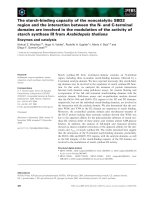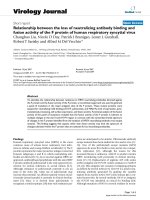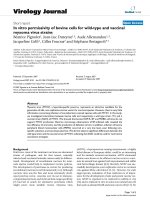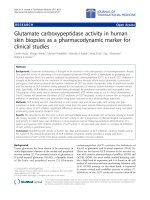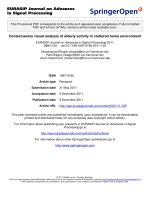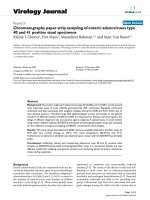Báo cáo sinh học: "n vitro activity effects of combinations of cephalothin, dicloxacillin, imipenem, vancomycin and amikacin against methicillin-resistant Staphylococcus spp. strains" pdf
Bạn đang xem bản rút gọn của tài liệu. Xem và tải ngay bản đầy đủ của tài liệu tại đây (228.79 KB, 5 trang )
BioMed Central
Page 1 of 5
(page number not for citation purposes)
Annals of Clinical Microbiology and
Antimicrobials
Open Access
Research
In vitro activity effects of combinations of cephalothin, dicloxacillin,
imipenem, vancomycin and amikacin against methicillin-resistant
Staphylococcus spp. strains
Guadalupe Miranda-Novales*
1
, Blanca E Leaños-Miranda
1
, Mariano Vilchis-
Pérez
2
and Fortino Solórzano-Santos
2
Address:
1
Unidad de Investigación en Epidemiología Hospitalaria, Coordinación de Investigación en Salud, Instituto Mexicano del Seguro Social.
Mexico City, Mexico and
2
Departamento de Infectología/Dirección Médica, Hospital de Pediatría, Centro Médico Nacional, Siglo XXI, Instituto
Mexicano del Seguro Social. Mexico City, Mexico
Email: Guadalupe Miranda-Novales* - ; Blanca E Leaños-Miranda - ;
Mariano Vilchis-Pérez - ; Fortino Solórzano-Santos -
* Corresponding author
Abstract
Background: combinations of drugs has been proposed as an alternative for oxacillin-resistant
staphylococci infections, however, limited information about in vitro combinations are available for
multi-resistant strains. The objective of this study was to describe the interaction of beta-lactams
in combination with vancomycin or amikacin against 26 oxacillin and amikacin-resistant nosocomial
Staphylococcus spp. isolates.
Methods: activity of dicloxacillin plus amikacin, cephalothin plus amikacin, cephalothin plus
vancomycin, imipenem plus vancomycin and vancomycin plus amikacin was evaluated by
checkerboard synergy tests and the fractional inhibitory concentration index (FIC) was calculated.
Results: dicloxacillin plus amikacin, and cephalothin plus amikacin were synergistic or partially
synergistic in 84.6% and 100% respectively. For nearly half of the isolates the mean concentrations
of dicloxacillin, cephalothin and amikacin at which FIC indexes were calculated were achievable
therapeutically. Vancomycin plus amikacin had synergistic effect only against two isolates, and
partially synergistic in 38.6%. For the combinations vancomycin plus cephalothin and vancomycin
plus imipenem the effect was additive in 76.9% and 80.7% respectively.
Conclusion: in this study the checkerboard analysis showed that amikacin in combination with
cephalothin or dicloxacillin was synergistic against most of the resistant strains of S. aureus and
coagulase-negative Staphylococcus. Vancomycin in combination with a beta-lactam (cephalothin or
imipenem) showed additivity. An indifferent effect predominated for the combination vancomycin
plus amikacin. Even though a synergistic effect is expected when using a beta-lactam plus amikacin
combination, it is possible that the effect cannot be clinically achievable. Careful selection of
antimicrobial combinations and initial MICs are mandatory for future evaluations.
Published: 12 October 2006
Annals of Clinical Microbiology and Antimicrobials 2006, 5:25 doi:10.1186/1476-0711-5-
25
Received: 11 July 2006
Accepted: 12 October 2006
This article is available from: />© 2006 Miranda-Novales et al; licensee BioMed Central Ltd.
This is an Open Access article distributed under the terms of the Creative Commons Attribution License ( />),
which permits unrestricted use, distribution, and reproduction in any medium, provided the original work is properly cited.
Annals of Clinical Microbiology and Antimicrobials 2006, 5:25 />Page 2 of 5
(page number not for citation purposes)
Background
Nosocomial staphylococcal infections are a health prob-
lem in different countries [1,2]. In the United States of
America there has been an increase in methicillin-resistant
Staphylococcus aureus (MRSA) nosocomial infections, from
2.1% to 35% in a 25-year period [3], with similar infor-
mation from other developed countries like Japan and
Canada [4,5]. In Mexico, antimicrobial resistance reports
about the frequency of MRSA and methicillin-resistant
(MR) coagulase-negative staphylococci (CoNS) are few,
with variable percentages between 20% and 60% [6-10].
Glycopeptides are considered the standard treatment for
infections due to MR Staphylococcus spp. strains, some
authors have expressed their concern about in vitro vanco-
mycin MICs and clinical outcomes in patients with MRSA
bacteremia [11], thus other available alternatives are
being considered (linezolid, tigecycline, daptomycin).
In Mexico, and other Latin American countries, vancomy-
cin was introduced in the early 90's and newer antibiotics
are expensive and available only in specialty hospitals.
Different antimicrobial combinations are prescribed regu-
larly; some of them include dicloxacillin or nafcillin plus
amikacin, cephalothin plus amikacin, and vancomycin
plus amikacin; however limited information about "in
vitro" or "in vivo" efficacy for these combinations is availa-
ble, particularly against nosocomial resistant isolates.
The objective of this study was to describe the interaction
of beta-lactams in combination with vancomycin or ami-
kacin against 26 oxacillin and amikacin-resistant nosoco-
mial Staphylococcus spp. isolates.
Methods
Bacteria
94 Staphylococcus isolates obtained from blood and sterile
fluids over a 7-month period from 2001 to 2003 were
stored at -70°C. The organisms were identified by conven-
tional methods (colonial morphology, Gram stain, and
catalase and coagulase tests). Species identification was
performed by using the API Staph system (Biomeriéux,
L'Etole, France). Antibiotic susceptibility was performed
with a broth microdilution method in accordance with
the CLSI [12]. The antimicrobials tested included dicloxa-
cillin (UPS-189009), cephalothin (Sigma Chemical Co,
St. Louis, Mo. USA), imipenem (Merck, Sharp and
Dohme, USA) amikacin (UPS-01950-8) and vancomycin
(UPS 70900-7). Oxacillin (UPS-48100-0) susceptibility
was performed by Mueller-Hinton broth supplemented
with 2% of NaCl. Resistance was corroborated by detect-
ing the mec A gene by PCR, by the method previously
described [13,14]. Reference type strains included for
quality control were: S. aureus ATCC # 29213 and S. aureus
# 43300. For the entire collection oxacillin resistance was
detected in 48.5% and 93.1% respectively for S. aureus
and CoNS.
Twenty six isolates, with resistance to oxacillin and inter-
mediate resistance or resistance to amikacin were selected
for the synergy tests. Strain identity was established by
pulsed-field gel electrophoresis (PFGE) [15], only single,
unrelated strains were included.
Synergy tests
The checkerboard technique was performed [16,17],
including the combinations: dicloxacillin/amikacin,
cephalothin/amikacin, cephalothin/vancomycin, imi-
penem/vancomycin and vancomycin/amikacin. Stock
solutions were prepared according to published standards
[12].
Synergy tests were performed in 96-well microtiter plate
containing two antimicrobial agents in two fold dilutions
dispensed in a checkerboard fashion on the day of the
assay. Each well contained 0.1 mL of individual antimi-
crobial combinations. Suspensions with turbidities equiv-
alent to that of a 0.5 McFarland standard were prepared to
yield a final inoculums of 3 × 10
5
to 5 × 10
5
CFU/mL.
MICs were read after overnight incubation at 35°C.
Growth and sterility controls were included in each plate.
Each isolate was tested twice.
Amikacin, dicloxacillin, and cephalothin concentrations
tested were from 0.125 to 1026 mg/L, and for vancomycin
from 0.06 to 8 mg/L.
Synergy tests interpretation
For the first clear well in each row of the microtiter plate
containing both antimicrobial agents, the fractional
inhibitory concentration (FIC) was calculated as follows:
FIC of drug A (FIC
A
) = MIC of drug A in combination/MIC
of drug A alone, and the FIC of drug B (FIC
B
) = MIC of
drug B in combination/MIC of drug B alone. If the MIC of
any agent alone occurred at the lowest or highest concen-
tration tested, the FIC was considered not determinable
and synergy could not be assessed. The suma of both FICs
in each well was used to classify the combination of anti-
microbial agents as synergistic effect when FIC indexes
were ≤ 0.5; partial synergy FIC >0.5 but < 1; additive FIC
= 1.0; indifferent effect when values were >1 and < 4 and
antagonistic when values were ≥ 4.0 [18].
Results and discussion
Resistance in vitro was 88.44% to dicloxacillin, 80.7% to
cephalothin, 69.23% to imipenem, and 100% to ami-
kacin (11.5% intermediate and 88.4% resistant) for the
26 isolates. All isolates were susceptible to vancomycin.
Annals of Clinical Microbiology and Antimicrobials 2006, 5:25 />Page 3 of 5
(page number not for citation purposes)
Results of the checkerboard synergy testing are summa-
rized in table 1. For most of the isolates the combination
cephalothin plus amikacin or dicloxacillin plus amikacin
showed a FIC < 1. When initial MICs were compared with
those registered in the antimicrobial combination, a drop
up to 10–12 dilutions in the checkerboard assays was
found for beta-lactams. For nearly half of the isolates the
mean concentrations of dicloxacillin, cephalothin and
amikacin at which FIC indexes were calculated were
achievable therapeutically. Combinations that included
vancomycin and a beta-lactam had FICs ≥ 1 and 2.
According to the FIC (table 2), dicloxacillin with amikacin
showed synergistic activity against 34.6% and partially
synergistic activity in 50% of the isolates, and additive
activity against the remainder four (15.6%), cephalothin
with amikacin was synergistic against 26.9% and partially
synergistic against the rest (73.07%). For cephalothin plus
vancomycin combination, the effect was additive against
76.9% (20/26), and indifferent for 23.1%, imipenem plus
vancomycin combination showed additivity against
80.7% (21/26) of the isolates and indifference against five
isolates. Finally, vancomycin and amikacin combination
was synergistic only in two isolates and partially synergis-
tic against 38.46%, and indifferent effect was shown
against 53.8% (14/26). None of the combinations
showed an antagonistic effect.
Multirresistant Staphylococcus strains are a common prob-
lem [4,10]. Reports of vancomycin tolerant or resistant
strains have promoted the performance of antimicrobial
interaction assays, using different combinations including
vancomycin. Some studies have demonstrated synergistic
effect for the combination of vancomycin and beta-
lactams [19-21], and there is some evidence supporting its
use in combination with aminoglycosides, in endocarditis
[22,23].
In our study, synergy was evident for dicloxacillin or
cephalothin in combination with amikacin, unfortu-
nately, not in all cases the MICs in combination will be
achieved therapeutically. In contrast with the results by
Rochon-Edouard et al., we did not find a synergistic effect
with the imipenem/vancomycin combination. The FIC
indexes were inversely correlated with the MICs of imi-
penem (32 and 64 mg/L). The strains included in the
present study required very high imipenem initial MICs
(512 mg/L), and lower vancomycin concentrations (1–2
mg/L), therefore, results are poorly comparable. Results
were similar for the vancomycin plus aminoglycoside
combination (indifferent effect). One of the main obsta-
cles to generalize the concept of the usefulness of antimi-
crobial combinations is the diversity of combinations in
published studies [24-26]. In developing countries, the
availability of new drugs, active against resistant strains is
limited due to its cost, combinations of traditional anti-
Table 1: MICs (mg/L) and FIC indexes of the 26 methicillin-resistant Staphylococcus spp.
SPECIES OX DX CEF IMP VAN AK DX/AK
a
FIC CEF/AK
b
FIC CEF/VAN
c
FIC IMP/VAN
d
FIC VAN/AK
e
FIC
S. aureus 32 1 64 256 1 32 0.5/4 0.63 0.5/1 0.037 64/1 2 256/1 2 0.5/8 0.75
S. aureus 16 128 64 8 1 32 8/4 0.18 8/1 0.16 32/0.5 1 4/0.5 1 0.5/8 0.75
S. aureus >32 32 64 8 1 512 8/128 0.5 8/64 0.25 64/1 2 4/0.5 1 1/64 1.12
S. aureus >32 512 256 1 0.5 64 0.125/32 0.5 2/16 0.26 1/0.5 1 0.5/0.25 1 0.125/32 0.5
S. aureus >32 512 64 512 2 128 2/4 0.03 1/64 0.52 64/2 1 256/1 1 0.125/32 0.31
S. aureus 8 32 32 8 2 128 8/32 0.5 4/64 0.62 32/2 2 8/2 2 2/16 1.12
S. aureus 8 2 0.5 8 1 128 1/64 1 0.125/64 0.75 0.25/0.5 1 4/0.5 1 1/64 1.5
S. aureus >32 512 2 256 1 512 0.125/4 0.5 0.5/64 0.75 1/0.5 1 128/0.5 1 1/128 2
S. aureus >32 128 128 8 2 128 0.5/32 0.25 16/64 0.52 1/2 1 4/1 1 0.5/64 0.75
S. aureus >32 512 512 1 2 512 0.125/128 0.5 32/256 0.56 128/1 1 0.5/1 1 0.5/128 0.5
S. epidermidis >32 512 4 256 0.5 32 1/8 0.25 0.125/8 0.28 2/0.25 1 128/0.25 1 0.06/0.125 0.12
S. epidermidis >32 512 256 512 2 512 0.125/512 1 8/128 0.28 0.125/2 1 256/1 1 0.125/256 0.56
S. epidermidis >32 512 32 512 1 128 0.125/64 0.5 0.25/64 0.5 0.125/1 1 256/0.5 1 0.125/64 0.62
S. epidermidis >32 512 128 512 1 512 0.5/128 0.25 0.125/256 0.5 0.25/1 1 256/0.5 1 0.125/512 1.12
S. epidermidis >32 512 256 512 1 128 2/64 0.5 1/64 0.5 128/0.5 1 256/0.5 1 1/16 1.12
S. epidermidis >32 512 4 512 1 128 1/64 0.5 0.125/64 0.53 2/0.5 1 256/0.5 1 1/16 1.12
S. epidermidis >32 8 2 512 1 128 4/64 1 0.125/64 0.56 0.125/1 1 256/0.5 1 0.125/64 0.62
S. epidermidis >32 512 4 512 1 64 0.5/16 0.25 0.25/32 0.56 0.25/1 1 256/0.5 1 0.125/64 1.12
S. haemolyticus >32 512 256 512 0.5 64 128/32 0.5 8/64 0.53 256/0.5 2 256/0.25 1 0.5/64 1.5
S. haemolyticus >32 256 512 512 2 128 1/64 0.5 2/64 0.5 256/1 1 256/1 1 2/16 1.12
S. haemolyticus >32 512 512 512 4 256 2/64 0.25 128/128 0.75 256/2 1 512/4 2 4/16 1.12
S. haemolyticus >32 512 512 512 2 256 2/256 1 16/128 0.53 512/2 2 512/2 2 2/128 1.5
S. hominis >32 128 64 256 4 128 2/64 0.5 16/64 0.75 32/2 1 128/2 1 1/64 0.75
S. hominis >32 256 256 256 4 512 2/256 0.5 16/256 0.56 128/2 1 128/2 1 4/256 1.5
S capitis >32 64 2 512 2 128 1/32 0.25 0.25/32 0.37 1/1 1 256/1 1 1/32 0.75
S. sciuri >32 128 128 8 2 64 1/16 0.25 2/32 0.5 128/2 2 8/2 2 2/8 1.12
MIC in combination for a = dicloxacillin plus amikacin, b = cephalothin plus amikacin, c = cephalothin plus vancomycin, d = imipenem plus vancomycin and e = vancomycin plus
amikacin.
Annals of Clinical Microbiology and Antimicrobials 2006, 5:25 />Page 4 of 5
(page number not for citation purposes)
microbial agents that exhibit synergy or even additive
activity could be an option.
Conclusion
The best synergistic combination was cephalothin or
dicloxacillin plus amikacin. The vancomycin combina-
tion with cephalothin or imipenem showed additivity.
Vancomycin and amikacin had and indifferent effect. In
vivo synergy and clinical efficacy cannot be predicted, but
information of in vitro assays with resistant strains, could
be useful to propose clinical studies to validate this infor-
mation, most of all, in developing countries with a lim-
ited formulary.
Competing interests
The author(s) declare that they have no competing inter-
ests.
Authors' contributions
MVP drafted the manuscript, collected strain information
and carried out identification of isolates. BLM carried out
the antimicrobial combinations tests. FSS participated in
the design and helped to draft the manuscript. GMN con-
ceived of the study, participated in the coordination and
helped to draft the manuscript. All authors read and
approved the final manuscript.
Acknowledgements
This work was partially supported by the institutional grant number 039
(IMSS/FOFOI).
References
1. Christensen GD, Bisno AL, Parisi JT, McLaughlin B, Hester MG,
Luther RW: Nosocomial septicemia due to multiply antibiotic
resistant Staphylococcus epidermidis. Ann Intern Med 1982,
96:1-10.
2. Martin MA, Pfaller MA, Wenzel RP: Coagulase-negative staphylo-
coccal bacteremia. Mortality and hospital stay. Ann Intern Med
1989, 110:9-16.
3. Panlilio AL, Culver DH, Gaynes RP, Banerjee S, Henderson TS, Tol-
son JS, Martone WJ: Methicillin-resistant Staphylococcus aureus
in US hospitals 1975–1991. Infect Control Hosp Epidemiol 1992,
13:582-586.
4. Suh K, Toye B, Jessamine P, Chan F, Ramotar K: Epidemiology of
methicillin-resistant Staphylococcus aureus in three Canadian
tertiary-care centers. Infect Control Hosp Epidemiol 1998,
19:395-400.
5. Aires de Sousa M, de Lencastre H, Santos Sanches I, Kikuchi K, Tot-
suka K, Tomasz A: Similarity of antibiotic resistant patterns
and molecular typing properties of methicillin-resistant Sta-
phylococcus aureus isolates widely spread in hospital in New
York City and in a hospital in Tokyo, Japan. Micro Drug Resist
2000, 6:253-8.
6. Alpuche-Aranda C, Avila-Figueroa C, Espinoza-De los Monteros L,
Gomez-Barreto D, Santos-Preciado JI: Patrón de sensibilidad
antimicrobiana de Staphylococcus aureus en un Hospital
Pediátrico: prevalencia de resistencia a meticilina. Bol Med
Hosp Infant Mex 1989, 46:700-703.
7. Giraud MC, Calva JJ, Huazano F, Ponce de Leon S, Ruiz-Palacios G:
Patrones de susceptibilidad a 19 antimicrobianos de
gérmenes aislados de hemocultivos en un hospital de refer-
encia de la ciudad de México. Rev Invest Clin 1986, 38:7-14.
8. Solórzano-Santos F, Miranda-Novales MG, Díaz-Ponce H, Leaños-
Miranda B, Fajardo-Gutiérrez A: Factores de riesgo para sepsis
en pacientes pediátricos con infección por Staphylococcus
coagulasa negativa. Bol Med Hosp Infant Mex 1994, 51:384-388.
9. Urdez-Hernandez E, Sifuentes-Osornio J, Calva JJ, Villalobos-Zapata
Y:
Epidemiological and biological characteristics of methicil-
lin-resistant staphylococcal infections in a Mexican Hospital.
Arch Med Res 1999, 30:325-31.
10. Santos Sanches I, Mato R, de Lencastre H, Tomasz A, CEM/NET Col-
laborators and the International Collaborators.: Patterns of multi-
drug resistance among methicillin-resistant hospital isolates
of coagulase-positive and coagulase-negative Staphylococci
collected in the International Multicenter Study Resist in
1997 and 1998. Microb Drug Res 2000, 6:199-211.
11. Moise-Broder PA, Sakoulas G, Eliopoulos GM, Schentag JJ, Forrest A,
Moellering RC: Accesory gene regulator group II polymor-
phism in methicillin-resistant Staphylococcus aureus is pre-
dictive of failure of vancomycin therapy. C I D 2004,
38:1700-05.
12. CLSI (Clinical and Laboratory Standards Institute): Performance
Standards for Antimicrobial Susceptibility testing. Fifteenth
Informational Supplement. CLSI document M100-S15. Pennsylvania USA
2005:19087-1898.
13. Tenover FC, Jones RN, Swenson JM, Zimmer B, McAllister S, Jor-
gensen JH: Methods for improved detection of oxacillin resist-
ance in coagulase-negative staphylococci: results of a
multicenter study. J Clin Microb 1999, 37:4051-58.
14. Kohner P, Uhl J, Kolbert C, Persing D, Cockerill F 3rd: Comparison
of susceptibility testing methods with mec A gene analysis for
determining oxacillin (methicillin) resistance in clinical iso-
lates of Staphylococcus aureus and coagulase-negative Sta-
phylococcus spp. J Clin Microbiol 1999, 37:2952-61.
15. Velázquez-Meza ME, Aires de Sousa M, Echaniz-Aviles G, Solorzano-
Santos F, Miranda-Novales G, Silva-Sanchez J, de Lencastre H: Sur-
veillance of methicillin-resistant Staphylococcus aureus in a
pediatric hospital in Mexico City during a 7-year period
Table 2: Antimicrobial combinations for reaction for synergy, partial synergy, additivity and indifference against 26 methicillin-
resistant Staphylococcus spp. isolates.
No. of isolates
Antibiotic combinations Synergy Partial Synergy Additivity Indifference
DK-AK
a
913 40
CEF-AK
b
719 00
CEF-VAN
c
00 206
IMP-VAN
d
00 215
VAN-AK
e
210 014
a
DX-AK dicloxacillin plus amikacin.
b
CEF-AK cephalothin plus amikacin.
c
CEF-VAN cephalothin plus vancomycin.
d
IMP-VAN imipenem plus vancomycin.
e
VAN-AK vancomycin plus amikacin
Publish with BioMed Central and every
scientist can read your work free of charge
"BioMed Central will be the most significant development for
disseminating the results of biomedical researc h in our lifetime."
Sir Paul Nurse, Cancer Research UK
Your research papers will be:
available free of charge to the entire biomedical community
peer reviewed and published immediately upon acceptance
cited in PubMed and archived on PubMed Central
yours — you keep the copyright
Submit your manuscript here:
/>BioMedcentral
Annals of Clinical Microbiology and Antimicrobials 2006, 5:25 />Page 5 of 5
(page number not for citation purposes)
(1997–2003):Clonal evolution and impact of infection con-
trol. J Clin Microbiol 2004, 42:3877-80.
16. Norden CW, Wentzel H, Keleti E: Comparison of techniques for
measurement of in vitro antibiotic synergism. J Infect Dis 1979,
140:629-33.
17. Rochon-Edouard S, Pestel-Caron M, Lemeland JF, Caron F: In vitro
synergistic effects of double and triple combinations of b-
lactams, vancomycin and netilmicin against methicillin-
resistant Staphylococcus aureus strains. Antimicrob Agents Chem-
other 2000, 44:3055-60.
18. Eliopolus GM, Moellering RC Jr: Antimicrobial combinations. In
Antibiotics in Laboratory medicine. 3rd edition. Williams and
Wilkins, Co. Baltimore, MD USA; 2000:432-49.
19. Dawis MA, Isenberg HD, France KA, Jenkins SG: In vitro activity of
gatifloxacin alone and in combination with cefepime, mero-
penem, piperacillin and gentamicin against multidrug-resist-
ant organisms. J Antimicrob Chemother 2003, 51:1203-11.
20. Climo MW, Patron RL, Archer GL: Combinations of vancomycin
and b-lactams are synergistic against staphylococci with
reduced susceptibilities to vancomycin. Antimicrob Agents Chem-
other 1999, 36:1747-53.
21. Raymond J, Vedel G, Bergeret G: In-vitro bactericidal activity of
cefpirome in combination with vancomycin against Staphylo-
coccus aureus and coagulase-negative staphylococci. J Antimi-
crob Chemother 1996, 38:1067-71.
22. Le T, Bayer AS: Combination antibiotic therapy for infective
endocarditis. C I D 2003, 36:615-21.
23. Lee DG, Chun HS, Yim DS, Choi SM, Choi JH, Yoo JH, Shin WS, Kang
MW: Efficacies of vancomycin, arbekacin, and gentamicin
alone or in combination against methicillin-resistant Staphy-
lococcus aureus in an in vitro infective endocarditis model.
Antimicrob Agents Chemother 2003, 47:3768-73.
24. Snydman DR, McDermott LA, Jacobus NV: Evaluation of in vitro
interaction of daptomycin with gentamicin or beta-lactam
antibiotics against Staphylococcus aureus
and Enterococci by
FIC index and timed-kill curves. J Chemother 2005, 17:614-21.
25. Lozniewski A, Lion C, Mory F, Weber M: In vitro synergy between
cefepime and vancomycin against methicillin-susceptible
and – resistant Staphylococcus aureus and Staphylococcus epi-
dermidis. J Antimicrob Chemother 2001, 47:83-6.
26. Raymond J, Vedel G, Bergeret M: In-vitro bactericidal activity of
cefpirome in combination with vancomycin against Staphylo-
coccus aureus and coagulase-negative staphylococci. J Antimi-
crob Chemother 1996, 38:1067-71.
